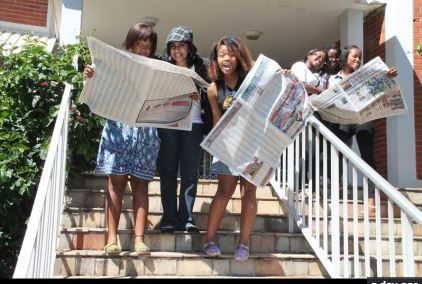Charles Molele
South Africa’s overall public schools matric pass rate for the Class of 2018 has improved by 3.1% from last year to 78.2%, Basic Education Minister Angie Motshekga announced on Thursday evening.
Excluding progressed learners, the pass rate was 79.4%, Motshekga added during a briefing in Midrand, Johannesburg.
“If we exclude progressed learners, we’ll be at 79.4, [which is] 0.6% short of the 80% we’ve been clamouring for all the years. So without progressed learners we’d be at 79.4%, but we don’t regret it,” she said.
For the first time in many years, Gauteng Province edged out the Free State to become the top performing province in the 2018 National Senior Certificate examination results.
The Free State and Gauteng provinces outperformed the rest of other provinces with their districts taking them top ten performing districts.
Gauteng has over eight best districts, four districts performed above 80% and six broke the ceiling with 90%.
“It is unprecedented that the ten top performing districts in the country, are from two provinces. It is for the first time that four of the top ten performing districts performed above 85%; and six of the top ten districts broke the 90% glass ceiling. Notably, out of the top ten performing districts in the country, eight are from Gauteng, and two are from the Free State. We must congratulate the Free State and Gauteng – this is remarkable!,” said Motshekga.
The top 10 performing districts in the country are as follows:
- Fezile Dabi in the Free State, with 92.3%
- Tshwane South in Gauteng, with 91.7%;
- Johannesburg East in Gauteng, with 90.3%;
- Sedibeng East in Gauteng, with 90.2%;
- Johannesburg West in Gauteng, with 90.1%;
- Thabo Mafutsanyana in the Free State, with 90%;
- Tshwane North in Gauteng, with 89.6%;
- Gauteng West in Gauteng, with 89.1%;
- Ekurhuleni North in Gauteng, with 88.8%;
- Johannesburg North in Gauteng, with 88.6%
The Eastern Cape, which has performed dismally in the past few years, improved its performance by 5% and achieved a pass rate of 70.6% – the largest improvement in the country.
“I must particularly single out the Eastern Cape. We must applaud the Eastern Cape for joining the 70% performance club, which includes the Northern Cape, KwaZulu Natal and Mpumalanga,” said Motshekga.
“The Eastern Cape had the largest performance improvement, while Mpumalanga and Limpopo had the second and third largest performance improvements, respectively. The learner support programmes and interventions these three provinces have implemented, are beginning to bear good fruit. I must particularly single out the Eastern Cape.
Despite the challenges they are faced with, especially the contestations related to the rationalisation of small and unviable schools, under the leadership of MEC Mandla Makupula (may his dear soul rest in peace),” she said.
“The Eastern Cape has now taken off, and should continue on this trajectory. It is about to reach its cruising height. I wish to encourage the executive and administrative leadership of the Eastern Cape, to keep the fires burning, in memory of the late MEC Makupula’s unobliterable and unforgettable legacy.”
Limpopo remained the worst performing province nationally.
“Only one province achieved below the 70% threshold, namely Limpopo, which achieved 69.4%, an improvement of 3.8% from 2017 – the third highest improvement,” she said.
“With the exception of Limpopo, all the other provinces achieved above the 70% pass rate. All the provinces, including Limpopo, have shown improvements in their performances, except for the Northern Cape and the Western Cape. We wish to implore the communities of the Northern Cape to desist from using schools as bargaining chips in their service delivery protests,” said Motshekga.
In recent years, Limpopo made headlines notorious for with failing to deliver to different schools on time.
The province experienced the same problems every year and the department was unable to solve them, according to Democratic Alliance.
Umalusi’s statistics for the 2018 national exams stated that there were 629,141 full-time matrics and 167,401 part-time matrics – making a total of 796,542 learners writing matric exams.
Of these, 33,413 were progressed learners who were pushed into matric from Grade 11. Motshekga said 60.2% of progressed learners passed their matric exams.
She added that 172,043 matric students achieved a bachelor’s pass, while 141,700 achieved a diploma pass. 86,800 achieved a higher certificate pass.






